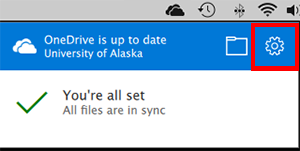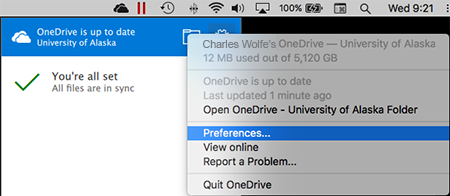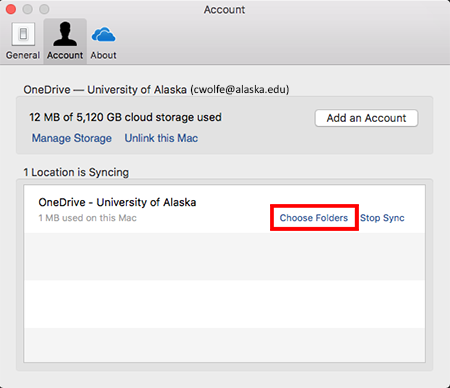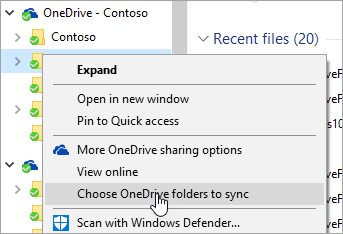OneDrive for Business
Important Notice: Some of the links on this page have been redirected to the new UAA Service Portal as separate KB articles. If a link has been updated, it will redirect you to the new location. In the coming future, all articles will be on the UAA Service Portal.
Background
UA OneDrive for Business is the University of Alaska's branding of the Microsoft Office 365 OneDrive for Business, an online service that provides resources for file storage, collaboration, and communication with other UA individuals. The OneDrive for Business service, aimed at enterprise users, is not the same as the OneDrive service offered by Microsoft to individuals. For information on the differences, visit Microsoft's What Is OneDrive for Business page and read the section titled How is OneDrive for Business different from OneDrive.
OneDrive for Business is a personal document and file storage hub. It's easy to upload, download, and share files. You can also create, view, and edit documents online using the integrated Office Online applications, Word, Excel, and PowerPoint. For those times you need the complete set of Office features, you can open your files in the full version of the applications and save them to your hard drive or back to the cloud.
Because OneDrive for Business is associated with your relationship to the University of Alaska, everything stored in it will be inaccessible should you leave the university. For this reason, it's best to use it to store materials that are your own personal university related (e.g. homework, business) use, like OneNote notebooks. For storing materials that are important for departments, schools, colleges, or other groups at the university indefinitely please consider using a SharePoint Online site instead.
Cost
OneDrive for Business is included in the University's Microsoft campus agreement for all current UA students, staff and faculty.
Eligibility
- UA OneDrive for Business is enabled automatically for all current UA students, staff, and faculty.
When you leave the University of Alaska:
- Faculty and Staff access to UA OneDrive for Business is disabled automatically after 14 days from their employment end date.
- Student access is disabled automatically after 1 year from their last active course enrollment.
Features
Store and share files
- Store up to 5 TB of data in the cloud.
- 250 GB maximum file size.
- Any files created in Office Online are automatically backed up in your OneDrive space.
- Easily recover deleted documents or roll back to previous versions.
- Share files with anyone across the University of Alaska system
Access and synchronize files easily
- Access files using a Web browser or mobile device.
- Access files directly from Microsoft Office desktop applications (with appropriate client software installed).
- Synchronize your local files in UA OneDrive for Business.
Best Practices
- Keep folder and file names short.
- Keep nested folder depth to a minimum.
- Review sharing/permissions at the beginning of each semester.
Create and edit Microsoft Office files in the cloud with Office Web Apps
- Word
- Excel
- PowerPoint
- OneNote
Getting Started
OneDrive for Business works well with all major, current web browsers. To access your UA OneDrive for Business just point your browser to https://portal.office.com and sign-in with your UA username (e.g. UaUsername@alaska.edu) and password. Click the App Launcher icon in the upper left (it is made up of nine squares), and select the OneDrive tile.
Alternatively, OneDrive for Business also comes with the ability to sync your files and folders to your desktop or mobile device.
To create a new document, click the + New icon, then select the desired file type. To open a file or folder, click on its name. To share a document, while viewing it in Office Online, click the + Share, enter the people you would like to share it with and whether they should be able to edit or just read, then click + Share.
To go back to a prior version of a document, while looking at the list of documents, hover over the desired document, then click the circle to the left of its name. Select the ellipse (...) from the menu above the list, then click Version history.
To retrieve a recently deleted document, click Recycle bin in the left-hand menu.
OneDrive for Business client guides
- Android (Moved to UAA Service Portal)
- iOS (Moved to UAA Service Portal)
- macOS (Moved to UAA Service Portal)
- Windows (Moved to UAA Service Portal)
- Web Browser (Moved to UAA Service Portal)
Information from Microsoft
Microsoft provides extensive online help for OneDrive for Business. When using OneDrive for Business, click the question mark icon in the upper-right corner of the browser window to access Microsoft help.
Other useful information from Microsoft:
- Microsoft OneDrive Quick Start Guide (pdf)
- What is OneDrive for Business? Describes OneDrive fo Business libraries and the OneDrive for Business sync client.
- Organize documents and sites in Office365. Describes how to use the basic features of OneDrive for Business.
- What do the OneDrive icons mean?
Frequently Asked Questions
-
How much space do I get in my UA OneDrive for Business storage area?
Each individual has 5 TB of space available.
-
Is there a size limit on the files that can be uploaded?
Yes, the largest individual file is 250 GB.
-
Why do I see references to SharePoint, SharePoint Online, and/or SkyDrive Pro?
Microsoft originally released OneDrive for Business service under the name SkyDrive Pro. In February 2014, Microsoft changed the name to OneDrive for Business. Regardless of which name they use for the service, the underlining technology which supports the service is called SharePoint Online.
-
How can I choose which OneDrive content to sync to my computer, tablet, or smartphone?
If you don't want to sync all of your folders, and files in OneDrive to your computer, you can specify which content you'd like to sync.
In the case of Android, and iOS devices (e.g. tablets and smartphones) the OneDrive client by default does not sync any content locally, instead opting to use a Wi-Fi or Cellular data connection to access the individual's online OneDrive storage. With these devices you can optionally select which files to make available for offline use.
- macOS
On macOS based computers do the following:
- From the menu bar, click the OneDrive menulet.

- Click the sprocket icon.

- Click Preferences.

- In the dialog window that appears click Account.

- In the Location is Syncing list next to OneDrive - University of Alaska click Choose Folders.

- In the Sync Files from Your OneDrive dialog box, uncheck any folders you don't want to sync to your computer and select OK.

- From the menu bar, click the OneDrive menulet.
- Windows
On Windows based computers do the following:
- In File Explorer, right-click the OneDrive - University of Alaska folder, and select Choose OneDrive folders to sync.

- In the Sync your OneDrive files to this PC dialog box, uncheck any folders you don't want to sync to your computer and select OK.

- In File Explorer, right-click the OneDrive - University of Alaska folder, and select Choose OneDrive folders to sync.
- Android
On an Android device do the following:
- Open the OneDrive app.
- Locate the file(s) and/or folder(s) you want available offline.
- Click and hold on the file's icon.
- Click the circle next to each file/folder you want to make available offline, then click the Parachute icon in the menu bar.
- When completed a small circle with a checkmark will appear next to the file(s) selected for offline use.
- iOS
On an iOS device do the following:
- Open the OneDrive app.
- Locate the file(s) you want available offline.
- Click and hold on the file's icon.
- Click the circle next to each file you want to make available offline, then click the Parachute icon in the menu bar.
- When completed a small circle with a checkmark will appear next to the file(s) selected for offline use.
Notes:
- If you uncheck a folder you are syncing to your computer, the folder will be removed from your computer. The folder and its contents will still be available online.
- The sync settings you choose are unique to each computer unless you're syncing everything everywhere. Also, if you're choosing folders on two computers and you create a new folder on computer A that you want to sync to computer B, you'll need to go to computer B and select the new folder there.
- macOS
-
Is there a limit to the number of items that can be synced?
Although SharePoint Online can store 30 million documents per library, the sync performance of OneDrive may start to decline when you store more than 100,000 files in a single OneDrive for Business site/library. If you have more than 100,000 files in a OneDrive for Business site, you may need to wait an extended period of time with OneDrive continuously syncing before sync can complete.
-
Is there a character limit for file and/or folder names?
In SharePoint Online, file name paths can have up to 400 characters. The limit may be less than 400 characters in some scenarios, especially if you have a very long URL path for the library.
-
Are there any characters which cannot be used in the file or folder name?
The following characters are not supported when you sync files with OneDrive for Business.
< > : " | ? * / \
Also do not start a file name with a tilde (~) character, nor name a folder _t, or _w. Additionally, you may not have a folder named "forms" at the root level of OneDrive.
-
Are there any invalid or blocked file types with OneDrive for Business?
There are not blocked files in OneDrive for Business, through there are some restrictions. For security reasons, a number of file names and extensions can't be uploaded since they are executable, used by SharePoint Server, or used by Windows itself. Additionally, you can't upload types of files that are blocked on the SharePoint site. For more information, see Microsoft's support article on Types of files that cannot be added to a list or library.
-
Can open files be synced?
A file that's currently opened by an application can't be synced by OneDrive for Business. To sync the file, close the application where the file is currently being used, and then sync the file.
This limitation doesn't apply to co-authoring scenarios when you use the Microsoft applications.
-
Customize How You Sync Your Documents
If you want to sync a different set of Office 365 files, click Sync A Different Library Instead and then provide the URL of the library. You'll be prompted for an account and password that can access that library. Alternatively Use your Web Browser and navigate to the library you wish to sync and select Sync.
-
What happens if I delete a file? Can it be recovered?
If you delete a file stored in OneDrive for Business, it will be in your OneDrive for Business recycle bin for 365 days. During this 365 day period you can "un-delete" the file be accessing your OneDrive for Business through the a web browsers and clicking on the Recycle Bin link on the left, selecting the desired file(s) and clicking the Restore button. After the 365-day window, it is gone and can not be recovered. There is no back-up.
-
Checking the Status of Your Files
- A green check on a folder means that it has been successfully synced.
- A blue circular arrow means it is currently being synced.
- A red arrow indicates a folder or file that is out of sync.
- Once the file synchronization starts you can click on the Show My Files button and open the local folder to see the files that are being synced.
-
Collaborating
More than one person can have a shared file open at the same time, this will be indicated one of two ways.
If you have the document open in the installed application on your computer, there should be an indicator at the bottom of the application window similar to this:
Clicking on the icon will display a list of the users that have the document open for editing.
When changes are made to a document by one user they are noted in the Web App by an icon. If you mouse over the icon it will tell you that changes have been made to the document and that saving the document will refresh and show you those changes.
In the Web App, you can click UPDATES AVAILABLE link in the information bar at the bottom of the browser window to refresh the page.
Then the other user's changes will be highlighted with a green overlay.
-
Why am I prompted to login sometimes and not at other times?
Windows workstations owned by the University of Alaska Anchorage and joined to the UA Active Directory domain are configured to support single sign-on with Office 365 services. If you've signed into the workstation with your UA Username and password you should automatically gain access to all Office 365 related services without the need to sign-in again.
Accessing Office 365 services, such as OneDrive for Business, from workstations not joined to the domain, or not able to support single sign-on will result in a prompt to login with your UA Username and password.
-
Is the data held securely? Is OneDrive for Business suitable for storing documents
which include personal data?
Yes. Data held in OneDrive for Business is encrypted at rest. It is also encrypted when in transit: being copied into, or downloaded from OneDrive for Business.
Encryption at rest includes two components: BitLocker disk-level encryption and per-file encryption of user data. Further, every update to every file is encrypted using its own encryption key.
-
I'd like to keep my files private. What do I need to do?
By default, any files you put into OneDrive for Business are only available to you. They are help privately. To make them available to other users, you would need to share them.
-
If I'm using OneDrive for Business to share files, do I need to consider the copyright
applying to those files?
Yes, depending on what you are sharing and who you are sharing it with, copyright may apply. Make sure you have the rights to share the material if there is copyright in it. You should not be using OneDrive for Business to share your music and/or video collection with your friends.
-
How can I check what I'm sharing to make sure I'm still not making something available
to someone who does not need to see it?
We recommend regular review of your shared documents. You should turn off sharing when collaboration has concluded. More information about sharing is available from Microsoft at:
Other related information
Need additional help or have issues
For additional assistance contact the IT Services Technical Support Center via phone at (907) 786-4646, toll-free at (877) 633-3888, or email at uaa.techsupport@alaska.edu.









